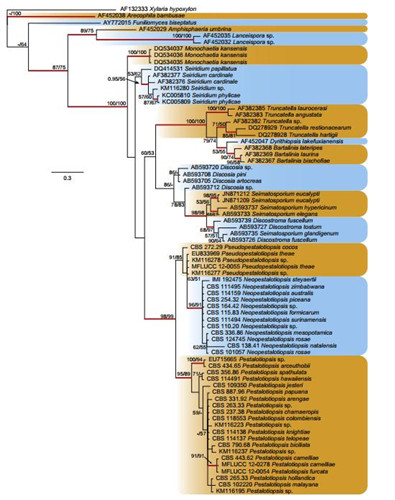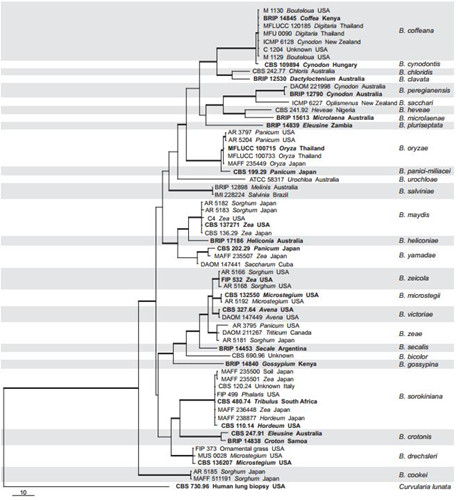The genus Pestalotiopsis is a highly creative genus which has been shown to produce more than 300 chemically novel, diverse, bioactive metabolites. Species of Pestalotiopsis commonly occur as plant pathogens or endophytes and have been the subject of considerable novel compound discovery research. Most of these novel compounds discovered from Pestalotiopsis were derived from unnamed species of the genus. It is only since 2011 that molecular studies were carried out on the genus Pestalotiopsis and as of July 2014, 36 species were recognized and had molecular data from ex-type species. The genus Bipolaris is an important plant pathogenic genus with a worldwide distribution. Its species have caused famine in Bengal when it devastated the rice crop and severe disease epidemics to corn production in the UK and USA. Species recognition in the genus has been uncertain due to the lack of molecular data from ex-type cultures as well as overlapping morphological characteristics.
Recently, the visiting Professor Kevin David Hyde in Kunming institute of Botany revised the genera Pestalotiopsis and Bipolaris based on morphological characters and molecular data.
In the first study, researchers reasinvestigated 91 Pestalotiopsis isolates. This research combined morphological and DNA data, and segregated two novel genera from Pestalotiopsis, namely Neopestalotiopsis and Pseudopestalotiopsis. The three genera are easily distinguishable on the basis of their conidiogenous cells and colour of their median conidial cells. Researchers coupled morphological and combined sequence data of internal transcribed spacer (ITS), partial β-tubulin (TUB) and partial translation elongation factor 1-alpha (TEF) gene regions, which revealed 30 clades in Neopestalotiopsis and 43 clades in Pestalotiopsis. Based on these data, 11 new species are introduced in Neopestalotiopsis, 24 in Pestalotiopsis, and two in Pseudopestalotiopsis (Fig 1). The fact that this chemically creative group comprises three distinct genera and more than 70 species which can now be accurately named mean the research can investigate this group further for novel compounds and relate the discoveries to named species. Furthermore, the fact that the group comprises so many similar species, points towards their different roles in nature, and thus the fact that the chemical novelty of species is far from being discovered. The closely related genera should also be investigated for novel chemicals.
In the second study, researchers revised the genus Bipolaris based on DNA sequence data derived from living cultures of fresh isolates, available ex-type cultures from worldwide collections and observation of type and additional specimens. Combined analyses of ITS, GPDH and TEF gene sequences were used to reconstruct the molecular phylogeny of the genus Bipolaris for species with living cultures. The GPDH gene was determined to be the best single marker for species of Bipolaris. Generic boundaries between Bipolaris and Curvularia, another important plant and human pathogenic genus, were revised and presented in an updated combined ITS and GPDH phylogenetic tree. The research now accept 47 species in the genus Bipolaris and clarify the taxonomy, host associations, geographic distributions and species’ synonymies (Fig. 2). Modern descriptions and illustrations are provided for 38 species in the genus with notes provided for the other taxa where recent descriptions are available. This study is important as it not only allows us to accurately identify Bipolaris species which may aid in disease control and future plant breeding efforts, but is very important for government quarantine lists as we have now established which taxa are pathogenic to which plant species.
Recently, two studies were published in the journal of studies in Mycology entitled to "Pestalotiopsis revisited" (http://www.sciencedirect.com/science/article/pii/S0166061614000116 ) and "The genus Bipolaris" (http://www.sciencedirect.com/science/article/pii/S0166061614000311 ), IF = 9.296. This Project was jointly funded by the National Natural Science Foundation of China and the Chinese Academy of Sciences.

Fig. 1. Consensus phylogramme (50 % majority rule) of 2 154 trees resulting from a Bayesian analysis of the LSU sequence alignment of Neopestalotiopsis, Pestalotiopsis, Pseudopestalotiopsis and other genera in family Amphisphaeriaceae.
Genera are indicated in coloured blocks and red-thickened lines indicate Bayesian posterior probabilities(PP) above 95 %. RAxML bootstrap support values (MLB) and maximum parsimony bootstrap support values (MPB) are given at the nodes (MLB/MPB). The scale bar represents the expected number of changes per site. The tree was rooted to Xylaria hypoxylon (GenBank AF132333). (Image by KIB)

Fig. 2. One of the four equally most parsimonious trees generated for Bipolaris from the parsimony analysis based on the combined alignment of ITS, GPDH and TEF sequences.
The thickened branches correspond to parsimony and maximum likelihood bootstrap support values 60 % and Bayesian posterior probability values 0.7. All ex-type cultures are printed in bold. The tree is rooted with Curvularia lunata (CBS 730.96). (Image by KIB)




